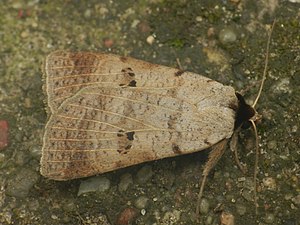Marbled wicked owl
| Marbled wicked owl | ||||||||||||
|---|---|---|---|---|---|---|---|---|---|---|---|---|

Marbled Wicked Owl ( Lygephila viciae ) |
||||||||||||
| Systematics | ||||||||||||
|
||||||||||||
| Scientific name | ||||||||||||
| Lygephila viciae | ||||||||||||
| ( Huebner , 1822) |
The marbled wicked owl ( Lygephila viciae ) is a butterfly ( moth ) from the family of the owl butterflies (Noctuidae). The specific epithet is derived from the food plants of the caterpillar, the vetch ( Vicia ).
features
butterfly
The wingspan of the moth is 40 to 44 millimeters. The color of the upper sides of the wings varies from gray-violet or gray-brown to dark gray. Sometimes there is a dark brown marbling. The transverse lines are indistinct, the submarginal area is darkened. At the front edge of the forewings small dark spots can sometimes be seen, but these are often completely absent. The large, dark, but usually somewhat indistinct or blotchy kidney defect is cut through by the brightly dusted veins. A flaw is usually missing. The back of the head and neck are noticeably hairy black-brown and velvety.
Caterpillar, pupa
Adult caterpillars are gray-brown to reddish brown in color. The fine dark brown topline is interrupted. The broad side ridge lines are also dark brown. There are white, black-pitted point warts on the entire surface of the body. The gray-brown head shows dark vertical stripes.
The red-brown doll has a few thorns on the wrinkled cremaster .
Similar species
The spots on the front edge are clearly recognizable on the very similar edge-patched wicked owl ( Lygephila craccae ). The kidney defect is narrow and undivided.
distribution and habitat
The distribution area of the marbled wicked owl extends from Western Europe through Central Asia to China and Japan . It is absent in the British Isles . In the Southern Alps, the occurrence reaches up to 1200 meters. The species primarily inhabits warm slopes, bushy forest edges, clearings, heaths and wasteland.
Way of life
The nocturnal moths fly in one generation in the north and two generations in the south from May to June or overlapping generations from May to October. You visit artificial light sources and baits . The caterpillars feed on the leaves of various types of vetch ( Vicia ). The species overwinters as a pupa.
Individual evidence
- ^ Arnold Spuler: The butterflies of Europe , Volume 1, E. Schweizerbart'sche Verlagsbuchhandlung, Stuttgart (E. Nägele), 1908
- ↑ Barry Goater, László Ronkay, Michael Fibiger: Catocalinae & Plusiinae. Noctuidae Europaeae, Volume 10., Sorø, 2003, ISBN 87-89430-08-5
- ^ A b Günter Ebert: The Butterflies of Baden-Württemberg Volume 5, Moths III. Ulmer Verlag Stuttgart 1997. ISBN 3-800-13481-0
- ↑ Walter Forster, Theodor A. Wohlfahrt: The butterflies of Central Europe. Volume 4: Owls. (Noctuidae). Franckh'sche Verlagshandlung, Stuttgart 1971, ISBN 3-440-03752-5 .
- ↑ Manfred Koch : We identify butterflies. Volume 3: Owls. 2nd, expanded edition. Neumann, Leipzig / Radebeul 1972, DNB 760072930 .
literature
- Barry Goater, László Ronkay, Michael Fibiger: Catocalinae & Plusiinae. Noctuidae Europaeae, Volume 10., Sorø, 2003, ISBN 87-89430-08-5
- Günter Ebert: The Butterflies of Baden-Württemberg Volume 5, Moth III. Ulmer Verlag Stuttgart 1997. ISBN 3-800-13481-0
- Walter Forster , Theodor A. Wohlfahrt : The butterflies of Central Europe. Volume 4: Owls. (Noctuidae). Franckh'sche Verlagshandlung, Stuttgart 1971, ISBN 3-440-03752-5 .
Web links
- Lepiforum e. V. - Taxonomy and photos
- www.leps.it - Moths and Butterflies of Europe and North Africa
- funet.fi - dissemination